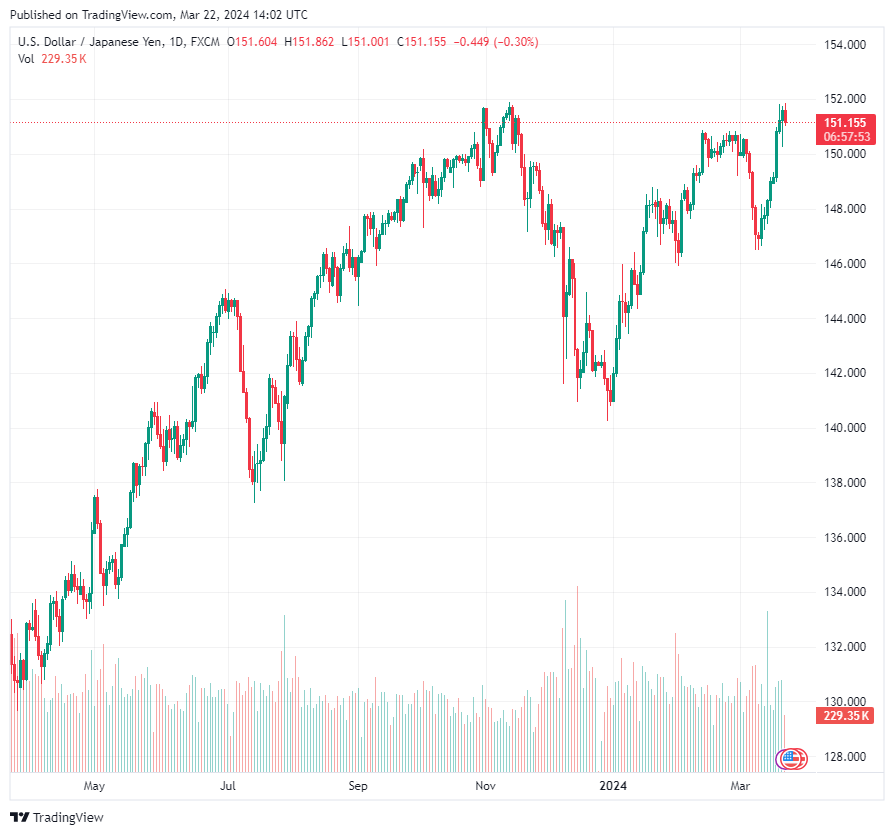The yen has historically been one of the most actively traded currencies in the world. It’s played the role of a foil for the US dollar, a safe haven in times of stress, and often as not it’s been the funding currency for carry trades, thanks to its low and sometimes negative interest rates.
Times change however and though the Yen remains a global reserve currency its place in the world has shifted. That’s because the BOJ allowed, or at least didn’t stop the currency, from weakening significantly over the last two years.
The Japanese yen has lost more than -26.00% of its value against the dollar in the last 24 months.

In truth, however, the Yen’s Real Effective Exchange Rate, or REER, has been falling for far longer.
- Related guide: Best brokers for trading USDJPY
Analysts at Societe Generale calculate that the yen has lost half of its value since the Global Financial Crisis, or GFC, of 2008.
Since then Japan’s GDP growth per capita has risen far more slowly than that in the US.
The battle against deflation in Japan appears to be won. Wages are rising, interest rates are no longer negative, and are expected to rise over time.
So what does all this mean for the Japanese currency and the dollar-yen rate?
USDJPY Predictions
Analysts expect the Yen to strengthen over the medium term against the USD, in the coming quarter the average forecast, among contributors, to FX Street’s weekly poll, comes in at 145.23 against the dollar compared to the current spot rate of 151.56.
However, if we put the fundamentals to one side for the moment, from a technical standpoint, it looks to me as though the yen could weaken further.
If, for example, it pushed cleanly through 152.00. A move that would open the door to 160.00.
Let’s not forget that the yen was trading at 277 to the greenback in the early 1980s, before rallying to trade at 87 in the mid-90s.
Japanese markets often act unpredictably and they rarely follow convention, so we shouldn’t take anything for granted.
Is USD JPY a good pair to trade?
Dollar yen is one best pairs to trade thanks to its deep liquidity, and its reserve currency status.
And, the tendency for the market to use the Yen as a source of funding.
By, for example, borrowing yen, at little or no cost, to buy currencies like the Mexican Peso, which has a notional yield of around 11.00% currently.
These flows mean that there is nearly always activity in dollar yen.
However, liquidity can occasionally be an issue, out of hours around long Japanese holidays.
The most recent Bank for International Settlements Triennial Survey found that the yen was the third most actively traded FX instrument, after the dollar, and the European single currency.
Accounting for more than +16.0 of daily global FX turnover, dollar yen made up the lion’s share of that trade.
USDJPY Trading strategy correlation
For the last two years it’s been right to be short the yen against most other currencies, and in particular the us dollar.
In that time Japanese interest rates were pegged below zero, whilst US dollar rates were rising. That may have changed now, with yen rates back at zero and US rates static for now, if not falling immediately. Near term the dollar seems to be strengthening once more, with the dollar index adding +0.93% on the week.
For now, then it looks as though the status quo will be maintained. Unless we break solidly below 150, from where we could move to the one-month high for the yen at 145.90.
However, to do that we would need a catalyst to put the yen back in demand. A further sharp rise in Japanese interest rates could make that happen, however, the Bank of Japan is conservative with a very small “c” so that seems unlikely to me.

With over 35 years of finance experience, Darren is a highly respected and knowledgeable industry expert. With an extensive career covering trading, sales, analytics and research, he has a vast knowledge covering every aspect of the financial markets.
During his career, Darren has acted for and advised major hedge funds and investment banks such as GLG, Thames River, Ruby Capital and CQS, Dresdner Kleinwort and HSBC.
In addition to the financial analysis and commentary he provides as an editor at GoodMoneyGuide.com, his work has been featured in publications including Fool.co.uk.
As well as extensive experience of writing financial commentary, he previously worked as a Market Research & Client Relationships Manager at Admiral Markets UK Ltd, before providing expert insights as a market analyst at Pepperstone.
Darren is an expert in areas like currency, CFDs, equities and derivatives and has authored over 260 guides on GoodMoneyGuide.com.
He has an aptitude for explaining trading concepts in a way that newcomers can understand, such as this guide to day trading Forex at Pepperstone.com
Darren has done interviews and analysis for companies like Queso, including an interview on technical trading levels.
A well known authority in the industry, he has provided interviews on Bloomberg (UK), CNBC (UK) Reuters (UK), Tiptv (UK), BNN (Canada) and Asharq Bloomberg Arabia.
To contact Darren, please ask a question in our financial discussion forum.



